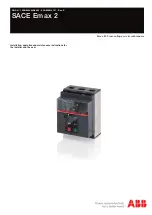
Page 40
I.B. 3A74792H08
Effective
09/2014
sliding contacts at the moving stem either. Instead they
use a highly reliable and unique flexible clamp design that
eliminates the need for lubrication and inspection for wear.
If desired, the DC resistance of the primary circuit may be
measured as follows: close the circuit breaker, pass at
least 100 amps DC current through the circuit breaker.
With a low resistance instrument, measure resistance
across the studs on the circuit breaker for each pole
(Figure
6-6
).The resistance should not exceed the values
shown in Table
6.4.
6-10 MECHANISM CHECK
Make a careful visual inspection of the mechanism for
any loose parts such as bolts, nuts, pins and rings.
Check for excessive wear or damage to the circuit
breaker components. Operate the circuit breaker sever-
al times manually and electrically. Check the closing and
opening times to verify that they are in accordance with
the limits in Table
5.1.
6-10.1 CLOSURE
™
TEST
Introduction:
The CloSure
TM
Test is a simple yet
extremely effective means to determine and monitor the
ability of the mechanism to close the breaker contacts
fully. It provides a quantitative measure of the extra energy
available in terms of over travel in inches to close the
breaker contacts to their full extent. It may be used
periodically to monitor the
health
of the mechanism.
At times, circuit breakers are called upon to operate MOC
switches (mechanism operated control switches) that
place extra load upon the closing mechanism of the circuit
breaker. If this load is excessive, it can prevent the circuit
breaker from closing fully. In such a case, it is important to
determine that the circuit breaker will close fully. The
CloSure
TM
Test provides this assurance.
General Information:
The CloSure
TM
Test can be per-
formed on the VCP-W, VCP-WR, VCPW-ND, DHP-VR, W -
VACR, W-VAC, W-VACW and W-VACWR lines of
vacuum circuit breakers Refer to Table
6.3
for a list of
circuit breakers. If the CloSure
TM
travel obtained is as
specified, the mechanism performance is satisfactory. If
the CloSure
TM
travel does not conform as shown in Figure
6-14,
contact Eaton for further information. (See Step
13
).
WARNING
DO NOT ATTEMPT TO INSTALL OR PERFORM
MAINTENANCE OR TESTS ON THE EQUIPMENT
WHILE IT IS ENERGIZED. NEVER PUT YOUR HANDS
NEAR THE MECHANISM WHEN THE CIRCUIT
BREAKER IS IN THE CHARGED OR CLOSED
POSITION. DEATH OR SEVERE PERSONAL INJURY
CAN RESULT FROM CONTACT WITH ENERGIZED
EQUIPMENT. ALWAYS VERIFY THAT
NO VOLTAGE PRESENT BEFORE PROCEEDING
NO VOLTAGE IS PRESENT BEFORE
PROCEEDING WITH THE TASK, AND ALWAYS
FOLLOW GENERALLY ACCEPTED SAFETY
PROCEDURES.
Safety Precautions:
Read and understand these
instructions before attempting any maintenance, repair
or testing on the breaker. The user is cautioned to
observe all recommendations, warnings and cautions
relating to the safety of personnel and equipment.
Figure 6-7 Status Indicators
( “ A ”
shows the
contact status indication and
“ B ”
shows the spring
indication.)
Figure 6-9 Wrapping Tape Up Around Cam
Summary of Contents for 380 VCP-W 21
Page 2: ......
Page 13: ...I B 3A74792H08 Page 7 Effective 09 2014 ...
Page 22: ...Page 16 I B 3A74792H08 Effective 09 2014 Figure 3 7 Typical VCP W 38kV Escutcheon ...
Page 23: ...I B 3A74792H08 Page 17 Effective 09 2014 Figure 3 8 Typical VCP W 38kV Escutcheon ...
Page 33: ...I B 3A74792H08 Page 27 Effective 09 2014 compartment Figure 5 5 Charging Schematic ...
Page 38: ...Page 32 I B 3A74792H08 Effective 09 2014 Figure 5 10 Undervoltage Trip Device Configuration ...
Page 60: ...Page 54 I B 3A74792H08 Effective 09 2014 ...
Page 62: ...Page 56 I B 3A74792H08 Effective 09 2014 Style 3A74792H08 Printed in USA ...






































